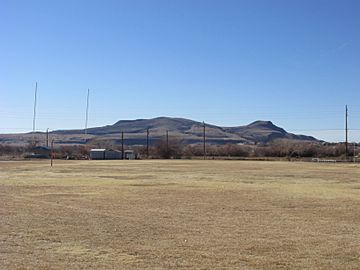Cat Hills volcanic field facts for kids
Quick facts for kids Cat Hills volcanic Field |
|
|---|---|

Los Lunas volcano
|
|
| Highest point | |
| Elevation | 1,750 m (5,740 ft) |
| Geography | |
| Location | New Mexico, United States |
| Geology | |
| Mountain type | volcanic field |
| Volcanic arc/belt | Rio Grande Rift |
| Last eruption | c. 140,000 years ago |
The Cat Hills volcanic field is a special area in New Mexico, USA, where many volcanoes have erupted over time. Each volcano in this field erupted only once. This is why it's called a monogenetic volcanic field.
Contents
Volcanoes of the Cat Hills Field
This volcanic area includes several volcanoes. These are the Cat Hills themselves, Wind Mesa, Isleta volcano, and Los Lunas volcano. Even though they are close to each other, they are made of different kinds of rock. They also erupted at different times in history.
Isleta Volcano
The oldest volcano in this field is Isleta volcano. It is located about 2 miles (3.2 km) west of Isleta Pueblo. Part of I-25 goes across its eastern side.
Scientists used a method called K-Ar dating to find its age. This method measures how much potassium and argon are in the rocks. They found that Isleta volcano is about 2.78 million years old.
Isleta volcano is a cone that grew on top of a maar. A maar is a wide, flat crater formed by an explosive eruption. The volcano is made of a dark volcanic rock called alkali olivine basalt.
Los Lunas Volcano
Los Lunas volcano is found on the eastern edge of Ceja Mesa. This is about 4 miles (6.4 km) west of Los Lunas.
Evidence shows that lava flowed from this volcano down the steep slope of the mesa. This means the volcano is younger than the mesa itself. K-Ar dating shows that its lavas are between 1.1 and 1.3 million years old. This age helps scientists understand when the Ceja Mesa formed.
From the east, the volcano looks very tall, rising about 1,100 feet (340 m). But from the west, it looks much shorter, only about 250 feet (76 m) tall. This volcano is made of a rock called andesite. It erupted from two vents that were close together.
The Cat Hills
The youngest volcanoes in the field are the Cat Hills themselves. They are a line of 23 cinder cones. A cinder cone is a cone-shaped hill made from volcanic ash and small rocks. These cones follow a hidden crack in the Earth.
This crack also erupted large lava flows. These flows cover an area of about 26 square miles (67 km2). The cinder cones vary in size. Some are 500 feet (150 m) wide and 70 feet (21 m) tall. Others are as small as 100 feet (30 m) wide and 20 feet (6.1 m) tall.
All the Cat Hills have craters at their tops. They look very young. Scientists have dated them to about 140,000 years ago. These cones are made of the same kind of rock as Isleta volcano: alkali olivine basalt. People have mined a lot of the volcanic rock from these hills. By 1978, one cone was completely removed.
Wind Mesa
Wind Mesa has not been dated yet. It seems to be just east of the same crack in the Earth as the Cat Hills. It is about 6 miles (9.7 km) west of Isleta volcano.
This mesa is cut by cracks in the ground on both its west and east sides. It is made of a type of volcanic rock called olivine-bearing basaltic andesite.
Important Volcanoes in the Field
Here is a table showing some of the important volcanoes in the Cat Hills volcanic field:
| Name | Elevation | Coordinates | Last eruption |
|---|---|---|---|
| Isleta volcano | 5,387 ft (1,642 m) | 34°55′08″N 106°43′41″W / 34.919°N 106.728°W | 2.78 million years ago |
| Wind Mesa | 200 ft (61 m) | 34°55′41″N 106°50′53″W / 34.928°N 106.848°W | - |
| Los Lunas volcano | 5,955 ft (1,815 m) | 34°47′56″N 106°47′49″W / 34.799°N 106.797°W | 1.1-1.3 million years ago |

